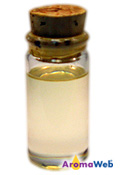Opoponax Essential Oil
Commiphora guidottii / Commiphora erythraea

Description
Opoponax Essential Oil is sometimes spelled Opopanax. It is also known as Sweet Myrrh Essential Oil. Myrrh Essential Oil and Opoponax Essential Oil are steam distilled from the resin from trees of the same genus, and their aromas share some similarity. However, Opoponax Oil tends to be a bit lighter and sweeter. If you find the aroma of Myrrh Oil a bit too intense, you may find Opoponax Essential Oil to be more pleasing aromatically.
Opoponax Essential Oil is quite versatile and blends well aromatically with many other oils including those in the wood, resin, spice, herbaceous, floral and citrus families. Within natural fragrancing applications, Opoponax Essential Oil is can be used as a middle or base note. It can act as a natural fixative to help prolong the aroma of the blend or fragrance.

As with Myrrh Essential Oil, Opoponax Essential Oil is deeply grounding and can help to mellow and balance out the emotions. It is used in spiritual and incense applications.
However, unlike Myrrh Essential Oil, Tisserand and Young report that Opoponax Essential Oil is phototoxic and that there is a moderate risk of skin sensitization when using Opoponax Essential Oil topically. See the Safety Information section below for more information.
Opoponax Essential Oil Benefits and Uses
- Antiseptic
- Antispasmodic
- Expectorant
- Fragrance Fixative
Source: Julia Lawless, The Encyclopedia of Essential Oils (Updated Edition) (London: Harper Thorsons, 2014), 150-151.
Botanical Name
Commiphora guidottii / Commiphora erythraea
Plant Family
Common Method of Extraction
Steam Distilled
Plant Part Typically Used
Color
Pale Yellow
Consistency
Thin
Perfumery Note
Middle/Base
Strength of Initial Aroma
Medium
Aromatic Description
Opoponax Essential Oil smells deep, resinous and woody. The aroma shares some similarity to that of Myrrh Oil.
Sustainability and Conservation Status
Vulnerable
Source: https://www.iucnredlist.org/species/35815/128435804
To learn more about the conservation status of essential oil bearing plants and how to use the IUCN Red List of Threatened Species, please refer to AromaWeb's Guide to Essential Oils and Sustainability.
Major Constituents
- (E)-B-Ocimene
- (z)-a-Bisabolene
- a-Santalene
- (E)-B-Bergamotene
- a-Bergamotene
- Germacrene D
- Decanol
Source: K.H.C. Baser, B. Demirci, A. Debeko, E. Dagne, Essential Oils of Some Boswellia spp., Myrrh and Opopanax. (Flavour & Fragrance Journal 18, 2003), 153-156. Source cited in Robert Tisserand and Rodney Young, Essential Oil Safety (Second Edition. United Kingdom: Churchill Livingstone Elsevier, 2014), 224.
Opoponax Essential Oil Safety Information
Tisserand and Young indicate that Opoponax Essential Oil is phototoxic and that there is moderate risk of skin sensitization when using the oil topically. They precaution against topical use for those with hypersensitive/diseased/damaged skin. They recommend a dermal maximum usage level of 0.6%. Reading Tisserand and Young's full profile is recommended. [Robert Tisserand and Rodney Young, Essential Oil Safety (Second Edition. United Kingdom: Churchill Livingstone Elsevier, 2014), 370-371.]
General Safety Information
Do not take any oils internally and do not apply undiluted essential oils, absolutes, CO2s or other concentrated essences onto the skin without advanced essential oil knowledge or consultation from a qualified aromatherapy practitioner. For general dilution information, read AromaWeb's Guide to Diluting Essential Oils. If you are pregnant, epileptic, have liver damage, have cancer, or have any other medical problem, use oils only under the proper guidance of a qualified aromatherapy practitioner. Use extreme caution when using oils with children and be sure to first read the recommended dilution ratios for children. Consult a qualified aromatherapy practitioner before using oils with children, the elderly, if you have medical issues or are taking medications. Before using this or any essential oil, carefully read AromaWeb's Essential Oil Safety Information page. For in-depth information on oil safety issues, read Essential Oil Safety by Robert Tisserand and Rodney Young.
Shelf Life
Important Information About the Profiles
The essential oil information provided on AromaWeb is intended for basic educational purposes only. The references to safety information, test results, constituents and percentages is generalized information. Essential oils can vary greatly in composition. The data is not necessary complete and is not guaranteed to be accurate. The essential oil photos are intended to represent the typical and approximate color of each essential oil. However, essential oil composition and color can vary based on harvesting, distillation, age of the essential oil and other factors. Profiles for several CO2 Extracts and absolutes are included within the directory, and are denoted as such.
